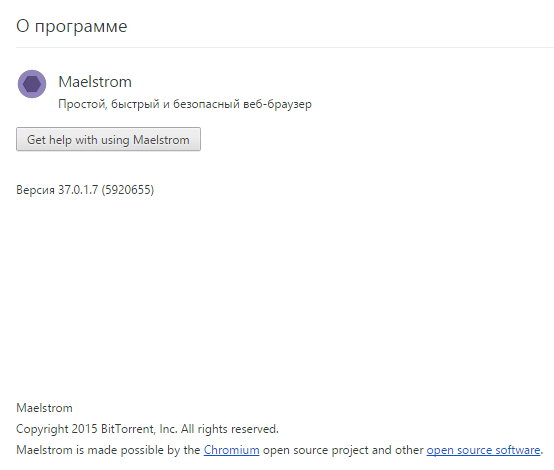Project Maelstrom released in public beta

Announced last year by Bittorrent Inc. The next-generation browser has entered the public beta testing phase.
Project Maelstrom is a browser based on the bittorrent protocol, which allows publishing static content on the network in the form of a familiar torrent in a matter of minutes. The first public beta is assembled in a 32-bit version, so far only for Windows, it will soon promise assembly for MacOS.
At first glance, the interface shows that the popular Chromium engine, a rather old, 37th version (September 2014), is taken as the basis.

The counter is shown on the main one, which in real time displays the number of people "hosting" the current page. At first, it seems that the counter is fictitious and flaunts just to attract attention, but by opening the Developer Tools on the Network tab, you can see live Json giving away the number of seeds, peers, the speed of return and reception.
Below on the main page of the browser there are test magnet links to torrent files. In case of clicking on the link, the browser thinks for a few seconds, reports that it is looking for peers, and then pretty quickly opens the page itself. The link in the address bar takes the form
bittorrent://HASH/PATH. In addition to this format, Maelstrom also understands magnet links and simple http links to torrent files. An attempt to open the main page magnet in a regular torrent client failed for some reason - it cannot receive meta data. And he doesn’t see some hashes at all in DHT. Chromium itself, of course, does not know how bittorrent. It, in fact, is a shell for the µTorrent client, hiding under the name “chrome.native.torrent.exe”, which starts with the browser and doesn’t try to end after the browser is finished - it remains to “distribute the Internet”.
Settings
In addition to the standard chrome interface, the developers introduced µTorrent settings: the size of the storage for distributions (5GB by default), the number of simultaneous active torrents (from 0 to 256, the default is 8), the limitation of the speed of reception / upload, as well as traffic for a certain period of time, settings proxies, crash reports and the torrent client port through which communication with the browser occurs:
Settings window

Hands
There is no graphical interface for creating distributions yet - everything is done with a special optimizing script in Python. The essence of its optimizations is to organize the sequence of downloading files, for example, index.html should be loaded first. Plus, a fixed portion of the torrent data portion is set to 16kb, because too large a size can affect the site’s loading speed.
Initial site siting needs to be started in the most common µTorrent or Bittorrent clients. Magnet links may not work with others, developers warn.
General impressions
In general, an interesting idea, loud PR and rather knee-high implementation.
In fact, a ready-made torrent client was taken, a browser in the form of Chromium is hung on it via the API, there are no convenient tools.
We can hope that this is only beta, and in a relatively short time there will be something more or less interesting, for example, an analogue of DNS.
